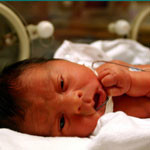Washington State Sees Spike in Rare Fatal Birth Defects
 For the fourth consecutive year the state of Washington has seen a significantly higher rate of rare, deadly birth defects in babies born there. The latest report from 2013 revealed that the disturbing trend continues: seven cases of anencephaly—a condition in which major portions of the brain, skull and scalp are missing during embryonic development—were reported in the same remote region of Washington, making 2013 the fourth year in a row that anencephaly rates have more than tripled the national average, according to state and federal health officials.
For the fourth consecutive year the state of Washington has seen a significantly higher rate of rare, deadly birth defects in babies born there. The latest report from 2013 revealed that the disturbing trend continues: seven cases of anencephaly—a condition in which major portions of the brain, skull and scalp are missing during embryonic development—were reported in the same remote region of Washington, making 2013 the fourth year in a row that anencephaly rates have more than tripled the national average, according to state and federal health officials.
With a little arithmetic, this means that 30 cases (cumulatively, since 2010) have emerged in the relatively remote counties of Yakima, Benton, and Franklin, in central Washington. Whereas the national rate of anencephaly is only 2.1 cases for every 10,000 births, Washington’s rate has skipped to 8.7 for every 10,000.
Washington birth defects causes unknown
Whether these tragic statistics are the result of bizarre coincidence or preventable human error remains hard to say. Officials are now expressing cause for concern.
“We’re really concerned about the fact that the anencephaly rates are still so high,” said Mandy Stahre, an Epidemic Intelligence Service officer with the Centers for Disease Control and Prevention based in Washington state. “We were sort of hoping that this may have been a statistical anomaly or would go away.”
Many locals think pollution from a nearby Hanford nuclear waste facility is the cause of this spike in rare birth defects; but University of Washington Medicine’s Dr. Edith Cheng is not so sure, citing insufficient study of the plant’s impact on brain defects to warrant this conclusion.
Brain defects like anencephaly have been linked to low levels of the vitamin folic acid, and molds and pesticides are another suspected link.
Washington’s spike in anencephaly—more investigation to come?
A growing chorus of critics has been asking for more in the way of a state and federal investigation into the problem, and questions have been asked as to why the disturbing rise in defects in this very small part of Washington did not receive more in the way of a public awareness campaign or coverage.
The problem first came to the attention of health officials when a nurse whose job was to oversee infection control and quality assurance at Prosser Memorial Hospital, a 25-bed medical center in a rural farm area on Yakima River, started doing the math. At the age of 58 Sara Barron had seen maybe one or two cases of anencephaly in her 30 years of nursing; all of a sudden, she began to notice that two cases of these fatal brain defects would come through her small hospital (averaging 30 deliveries monthly) in just one six-month period.
“Then, I was talking to another doctor about it and she has a third one coming,” Barron recalled. “My teeth dropped. It was like, ‘Oh my God.’”
Soon after Barron notified state officials.
Anencephaly almost always means (with very rare exceptions) that a baby with the birth defect will die.

